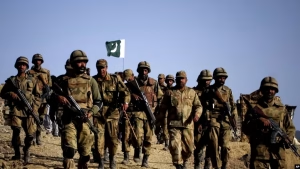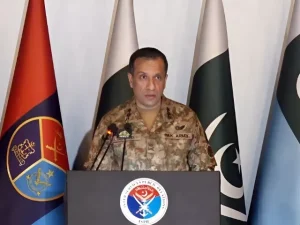New Delhi – In a significant escalation between the two nuclear-armed neighbors, Pakistan prepares for counter attack against India after accusing its rival of targeting three military bases with missiles fired from fighter jets. The retaliatory operation, named “Bunyan Ul Marsoos” (meaning “wall of lead” in Arabic), marks the most serious confrontation between the countries in decades and threatens to push the region to the brink of full-scale conflict.
Pakistan Prepares for Counter Attack Following Missile Strikes on Military Bases
“India, with its naked aggression, has attacked with missiles. Nur Khan base, Murid base and Shorkot base have been targeted,” announced Pakistan military spokesperson Ahmed Sharif Chaudhry during a live broadcast on state television early Saturday. According to Pakistani officials, India fired six ballistic missiles from across the border in Punjab, though most were reportedly intercepted by Pakistani air defenses.

As Pakistan prepares for counter attack, officials confirmed that retaliatory strikes had already begun under Operation Bunyan Ul Marsoos. The operation specifically targeted the Pathankot military airfield in Punjab and Udhampur air force base in Indian-administered Kashmir, with witnesses reporting loud explosions from both locations. Explosions were also heard in Srinagar, the main city in Indian-administered Kashmir.
In response to these developments, Pakistan shut down its airspace as part of broader measures while Pakistan prepares for counter attack against what it characterizes as Indian aggression. This closure demonstrates the severity of the current situation and Pakistan’s anticipation of potential further escalation.
Also Read: Pakistan Drone Attack in Barmer: India Defends Massive Aerial Assault
Targeting of Nur Khan Base as Pakistan Prepares for Counter Attack


The targeting of Nur Khan air base in Rawalpindi represents a particularly significant development as Pakistan prepares for counter attack. Located approximately 10 kilometers from Islamabad, the Pakistani capital, Nur Khan serves as a key military installation near the headquarters of Pakistan’s armed forces.
Video footage shared across social media platforms showed flames and smoke billowing into the night sky following strikes on the base, with audible voices noting, “There has been an attack on Nur Khan base as fighter jets flew past.” The early morning strikes on this facility, situated in a densely populated area, caused mass panic among local residents.
“There was a loud explosion which woke everyone up. It was so scary, everyone is still in a panic,” reported one resident living near the base. Such testimonies highlight the immediate civilian impact of these military exchanges as Pakistan prepares for counter attack.
Escalation Timeline Leading to Pakistan Prepares for Counter Attack
The current crisis represents the culmination of a rapid series of escalations between the two nuclear powers. On Wednesday, India conducted strikes against nine sites in Pakistan, resulting in 31 reported casualties. India characterized these actions as retaliation for an attack in Indian-administered Kashmir in late April, where militants allegedly killed 25 Hindu tourists and a guide—an incident India claims had Pakistani involvement.
As Pakistan prepares for counter attack, officials point to this sequence of events as evidence of India’s aggressive posture. The targeting of Pakistani military bases came shortly after India accused Pakistan of launching a wave of drone attacks across 26 locations spanning Punjab and Indian-administered Kashmir on Friday night, with explosions reported near Srinagar’s airport.
Drone Warfare Precedes Pakistan Prepares for Counter Attack
India’s military claimed that Pakistan had launched an extensive drone campaign involving approximately 400 unmanned aerial vehicles targeting cities, military installations, and religious sites across northern India on Thursday. Indian officials stated they intercepted hundreds of these drones, which reportedly crossed the border into Indian-administered Kashmir, Rajasthan, Punjab, and Gujarat.
According to Indian accounts, the drones arrived in two distinct waves—one on Thursday evening and another near dawn on Friday. India reported that it responded with four drone strikes against Pakistan, specifically targeting military defense infrastructure before Pakistan prepares for counter attack.
In a press briefing, Indian officials alleged that Pakistan’s drone operations had targeted a gurdwara (Sikh place of worship), resulting in civilian injuries, and had also targeted Christian churches. “The targeting of temples, gurdwaras, convents is a new low by Pakistan,” declared India’s Foreign Secretary Vikram Misri.
Pakistan’s Denial and Strategic Positioning as Pakistan Prepares for Counter Attack
Pakistan’s Information Minister Attaullah Tarar initially denied responsibility for the drone attacks, asserting that Pakistan had not undertaken any “offensive actions” within Indian Kashmir or beyond Pakistan’s borders. However, this statement was contradicted by a Pakistani security official who characterized Thursday night’s drone strikes as merely intended to “heat things up” before Pakistan prepares for counter attack in a more comprehensive manner.
“When we hit back, everyone will know,” the security official stated, suggesting that Pakistan’s full response was still forthcoming. This rhetoric indicates that Pakistan prepares for counter attack with a calculated strategy rather than reacting impulsively to Indian actions.
Military Claims and Counter-Claims as Pakistan Prepares for Counter Attack


The Pakistani military provided additional details regarding Wednesday’s confrontation, claiming that Pakistan had deployed over 100 aircraft to counter the Indian strikes. According to Pakistani accounts, the two sides engaged in an hour-long aerial dogfight, with Pakistan utilizing Chinese-made weapons and ground air defenses to reportedly down five Indian fighter jets.
As Pakistan prepares for counter attack, it has publicized claims about shooting down Indian aircraft, including at least one elite French Rafale jet. Debris from what appeared to be three fighter jets was reportedly visible in Indian-administered Kashmir and Punjab, though India has yet to respond to these specific allegations.
“We will not de-escalate – with the damages India did on our side, they should take a hit,” declared Pakistan’s military spokesperson, Ahmed Sharif Chaudhry, at a media briefing. “So far we have been protecting ourselves but they will get an answer in our own timing.” This statement encapsulates Pakistan’s position as Pakistan prepares for counter attack on its own terms.
Indian Military Response as Pakistan Prepares for Counter Attack
India’s Ministry of Defence issued a statement indicating: “The Indian Armed Forces are maintaining a high state of alert, and all such aerial threats are being tracked and engaged using counter-drone systems.” This statement underscores India’s readiness to respond as Pakistan prepares for counter attack.
The Indian Army reported that while they had largely intercepted the Pakistani drones, three people in the Ferozepur district of Punjab (which borders Pakistan) had sustained injuries from drone attacks, with one victim in critical condition. These civilian casualties further inflame tensions as Pakistan prepares for counter attack.
Civilian Impact as Pakistan Prepares for Counter Attack
Reports from both countries indicate civilian populations near military installations are experiencing significant anxiety and disruption. In Rawalpindi, residents fled into the streets following explosions at Nur Khan base. Similar scenes of panic have been reported in border areas of Indian Punjab and Kashmir.
As Pakistan prepares for counter attack, civilian protection remains a concern for international observers. The proximity of major military installations to populated areas in both countries means that any significant exchange of fire carries substantial risk to non-combatants.
International Reaction as Pakistan Prepares for Counter Attack
The international community has expressed growing alarm as Pakistan prepares for counter attack against India. The exchange of missile strikes between nuclear-armed neighbors represents a situation of global significance that could potentially draw in other regional powers or international stakeholders.
Diplomatic channels remain open, though the rapidly escalating nature of the conflict suggests that immediate de-escalation may prove challenging. As Pakistan prepares for counter attack and India maintains its defensive posture, the coming days will be critical in determining whether the situation can be contained or will continue to deteriorate.
Final Word: Critical Juncture as Pakistan Prepares for Counter Attack
With Operation Bunyan Ul Marsoos now underway, the South Asian region stands at its most dangerous crossroads in decades. As Pakistan prepares for counter attack, both nations face critical decisions about the extent and nature of military operations that could determine whether this confrontation remains limited or escalates further.
The use of ballistic missiles and targeting of air bases represents a significant departure from previous conflicts between the two countries. As Pakistan prepares for counter attack and India responds, the potential for miscalculation remains the most concerning aspect of the current crisis for regional stability and global security.

